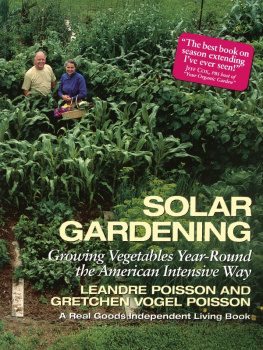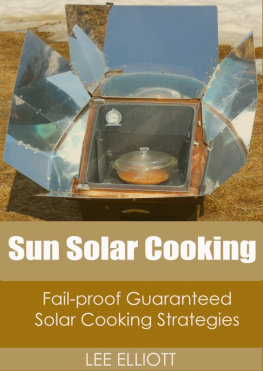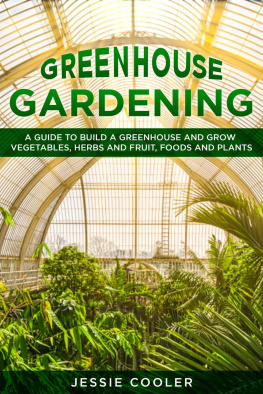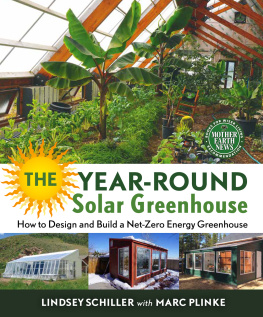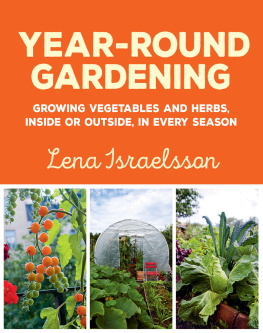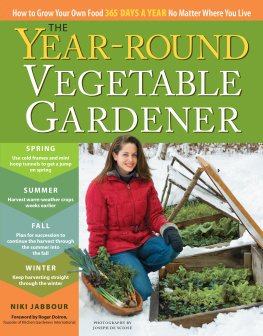SOLAR GARDENING
THE REAL GOODS INDEPENDENT LIVING BOOKS
Paul Gipe
Wind Power for Home & Business:
Renewable Energy for the 1990s and Beyond
Michael Potts
The Independent Home:
Living Well with Power from the Sun, Wind, and Water
Gene Logsdon
The Contrary Farmer
Edward Harland
Eco-Renovation: The Ecological Home Improvement Guide
Real Goods Solar Living Sourcebook:
The Complete Guide to Renewable Energy Technologies & Sustainable Living, Eighth Edition
edited by John Schaeffer
Leandre Poisson and Gretchen Vogel Poisson
Solar Gardening: Growing Vegetables Year-Round the American Intensive Way
Real Goods Trading Company in Ukiah, California, was founded in 1978 to make available new tools to help people live self-sufficiently and sustainably. Through seasonal catalogs, a quarterly newspaper (The Real Goods News), the Solar Living Sourcebook, as well as a book catalog and retail outlets, Real Goods provides a broad range of renewable-energy and resource-efficient products for independent living.
Knowledge is our most important product is the Real Goods motto. To further its mission, Real Goods has joined with Chelsea Green Publishing Company to co-create and co-publish the Real Goods Independent Living Book series. The titles in this series are written by pioneering individuals who have firsthand experience in using innovative technology to live lightly on the planet. Chelsea Green books are designed to be both practical and inspirational, and to enlarge our view of what is possible as we enter the next millennium.
Ian Baldwin, Jr.
President, Chelsea Green
John Schaeffer
President, Real Goods
SOLAR
GARDENING
Growing Vegetables Year-Round
the American Intensive Way
LEANDRE POISSON AND
GRETCHEN VOGEL POISSON
Illustrations by Robin Wimbiscus
and Leandre Poisson
CHELSEA GREEN PUBLISHING COMPANY
White River Junction, Vermont
We wish to thank Paul Burnham for his organic resources and Robert Keller, Sr., for his belief in our research. Our thanks to Ray Wolf for his past and present contributions and to Al Johnson for his participation in our gardening efforts, to Sy Montgomery and Howard Mansfield, and to Joni Praded for connecting us to Chelsea Green. Thanks also to Tim Walsh and Vinoy Laughner for all their timely disk translations. Kudos to the Chelsea Green team: Ben Watson, Steve Rioch, Jim Schley, Jill Shaffer, Robin Wimbiscus, Jill Mason, and Linda Ottavi. Most of all, our thanks go to Ian Baldwin, Jr., for his steadfast support of this project.
Text and building drawings copyright 1994 Leandre Poisson and Gretchen Vogel Poisson
Illustrations copyright Robin Wimbiscus
Photographs, unless otherwise credited, are by the authors
Design by Jill Shaffer
The names Solar Cone, Solar Pod, and Pod Extender are trademarks for the products developed and marketed by Solar Survival, Harrisville, NH.
All rights reserved. No part of this book may be transmitted or reproduced in any form by any means without permission in writing from the publisher.
Printed in the United States of America
Library of Congress Cataloging-in-Publication Data
Poisson, Leandre, 1935
Solar gardening: growing vegetables year-round the American Intensive way/l eandre Poisson and Gretchen Vogel Poisson.
p. cm.(The Real Goods independent living book)
Includes bibligraphical references (p. ).
eBook ISBN: 9-781-60358-123-3
1. Vegetable gardeningUnited States. 2. Organic gardeningUnited States. 3. Solar greenhousesUnited States. 4. Vegetable gardening. 5. Organic Gardening. 6. Solar greenhouses. I. Poisson, Gretchen Vogel, 1951 . II. Title. III. Series.
SB324.3.P65 1994
635.0483dc20
94-25475
CIP
Chelsea Green Publishing Company
Post Office Box 428
White River Junction, Vermont 05001
I have often thought that if heaven had given me choice of my position and calling, it should have been on a rich spot of earth, well watered, and near a good market for the productions of the garden. No occupation is so delightful to me as the culture of the earth, and no culture comparable to that of the garden. Such a variety of subjects, some one always coming to perfection, the failure of one thing repaired by the success of another, and instead of one harvest a continued one through the year. Under a total want of demand except for our family table, I am still devoted to the garden. But though an old man, I am but a young gardener.
THOMAS JEFFERSON
to Charles Willson Peale, August 20, 1811
This book is dedicated to the memory of
ROBERT RODALE
(19301990)
organic agricultures greatest champion
Contents
List of Tables
T HE MAGIC OF THE UNIVERSE IS contained in a garden. To see it one must be very still and pay close attention to what goes on there. The magic of life is there.
Twenty-three years ago, when we set out to see if it was possible to feed ourselves, we had no idea where this endeavor would lead us. As we acquired skills, knowledge, and experiences, the garden became a place where our personal, spiritual, and intellectual growth occurred. Understanding what plants are made of led us to the knowledge of what we ourselves are and what we are made of.
In the garden we came to a joyous realization. We learned that we are made of light: that we are solar creatures and are solar energized. The plants, via photosynthesis, catch and absorb photons of light emitted from the sun. This accumulation of light, in combination with a few minerals and water from the earth, is what comprises the body of the plant. Thus, when we eat the plant, the sunlight, water, and minerals that make up the plant provide us with motor energy and with the elements we need for replenishing our bodies. They become us.
When a log of wood burns in a fireplace, the light we see and the heat we feel is the sunshine that was trapped and stored in the tree. The burning process releases this light and allows it to return to the universe. The majority of its dry mass was sunlight. In the same way, a completely dried-up human body will burn like a leaf, releasing the photons that were a major part of it. The ashes that remain represent the minerals that the tree, or the body, borrowed from the earth.
These minerals are mined for us by the edible plants from the soil. They make up a small percentage of our body weight (approximately 3 percent) and are harvested at an atomic size and utilized by our bodies at that scale.
Next, we realized that plants, and indeed all living things, are hydraulic mechanisms. Humans are made up of approximately 73 percent water. The water in a human body represents its nutrient transportation system, its mechanical fluid, and its cooling and cleaning system.
All living things must continuously have clean water, which they use and then pass out. The water that is in us and in all of the biosphere is the same water that has been inside all of the dinosaurs, bugs, tigers, trees, whales, sequoias, and everyone and everything that has ever lived on this planet. There is no new water. It is the same water used over and over again in all living creatures since life took hold here on earth.
Since the moment of its creation, the universe has gone from a temperature in the trillions of degrees to its current average temperature of approximately 3 degrees above absolute zero on the Kelvin scale. Within this enormous thermal span, we and all the other living creatures can exist only in a very narrow temperature range. Water will solidify at 32F. and will vaporize at approximately 210F. Because our bodies are essentially bags of water, human life is only possible within this miniscule temperature gap. The operating temperature for our physical body is 98.6F., and we function best in ambient temperatures between 65 and 75F.
Next page
